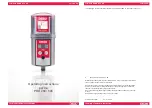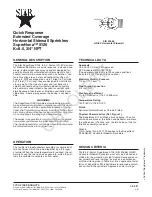
41
42
Learn more. Visit hunterindustries.com/golf
INLET VALVE INSTALLATION
INLET VALVE INSTALLATION
I
Next, slightly rotate the tool counter-clockwise to the 11:30 position. This alignment will allow the
two metal hooks on the G800 Valve Tool to pass through the two correct openings around the
outside of the inlet valve. Press the metal hooks through the openings. Continue pressing the
inlet valve and G800 Valve Tool together compressing the spring on the tool (FIGURE 106). While
holding the tool down with the spring compressed, turn the tool’s handle clockwise until it stops.
Next, release the spring’s compression by lifting the handle slightly on the G800 Valve Tool. This
action hooks and locks the inlet valve to the tool. Check to make sure that the pointer arrow on
the tool is directly above the communication port on the inlet valve and that the valve is securely
hooked to the tool.
Next, insert the assembled tool, white lower snap ring and inlet valve into the rotor’s body cavity.
To do so, it is necessary to align the pointer arrow on the G800 Valve Tool with the alignment dot
on the rotor’s flange. The alignment dot is centered on the flange compartment lid adjacent to
(next to) the body cavity opening (FIGURE 107). A second alignment dot is located below the lid
in case the flange compartment lid has been removed. Align the pointer arrow on the tool with
the alignment dot and lower the assembled tool, white lower snap ring and inlet valve into the
rotor’s body.
As the G800 Valve Tool is lowered into the rotor’s body, recessed areas on the black plastic part on
the tool will engage vertical rails inside the body wall (FIGURE 108). The tool must engage these
rails or the inlet valve’s communication port will not align with the communication port in the
body cavity below. Continue pressing the assembled tool, white lower snap ring and inlet valve
downward into the rotor’s body. Once the tool reaches the bottom, continue pressing firming to
securely seat the inlet valve and snap ring.
A distinct “click” sound should be heard as the
snap ring is released and engages the snap ring
groove in the rotor’s body cavity. After the inlet
and white lower snap ring have been properly
seated, press down on the tool then rotate
counter-clockwise to disengage the tool’s
metal hooks from the inlet valve. Next, raise
the G800 Valve Tool out of the body. Finally,
take whatever time is necessary to visually
confirm that every part of the white lower snap
ring is securely seated into the snap ring groove.
Inlet valve installation option 2
– The
alternative method to installing the G800 inlet
valve is to use the 16” Needle-Nose Pliers Tool.
First look at the top of the inlet valve and notice
the raised wall or rib that protrudes upward
from the center. During installation, the 16”
Needle-Nose Pliers Tool is used to grab this
protruding rib on the inlet valve. Next, look
at the side of the inlet valve and notice the
communication port. During installation, this
communication port must engage the
communication port at the bottom of the rotor’s
body cavity. Now notice that directly above the
communication port there is a slot feature on
the valve’s outside ring (FIGURE 109). During
installation, this slot feature must engage the
vertical rail of plastic located on the rotor body’s
inside wall. The vertical rail is located directly
above the communication port at the base of
the rotor’s body cavity.
Grab the protruding rib on the inlet valve firmly
with the 16” Needle-Nose Pliers Tool. Next, insert
the inlet valve into the rotor’s body cavity. It is
necessary to align the valve’s communication
port and/or the slot feature with the alignment
dot on the rotor’s flange (FIGURE 110). The
alignment dot is centered on the flange
compartment lid adjacent to (next to) the
body cavity opening. A second alignment dot
is located below the lid in case the flange
compartment lid has been removed.
With the valve’s communication port and/or the
slot feature aligned to the dot on top of the rotor,
carefully lower the inlet valve into the rotor’s
body. If the inlet valve is properly engaged with
the vertical rail in the body, it will not be possible
to rotate the inlet valve. If the inlet valve can be
rotated in either direction, pull the inlet out and
start again. With the inlet valve engaging the
body’s vertical rail, continue lowering the valve
into the rotor’s body. It is important to keep the
inlet valve vertical in order to allow the valve’s
rock screen to enter the inlet of the body. Once
the inlet valve reaches the bottom, continue
pressing firming to securely seat the inlet valve.
Fig 104
Fig 105
Fig 106
Fig 107
Fig 106
Fig 107
FIGURE 106
FIGURE 107
FIGURE 108
Fig 108
Fig 109
Fig 108
Fig 109
FIGURE 109
FIGURE 110










































